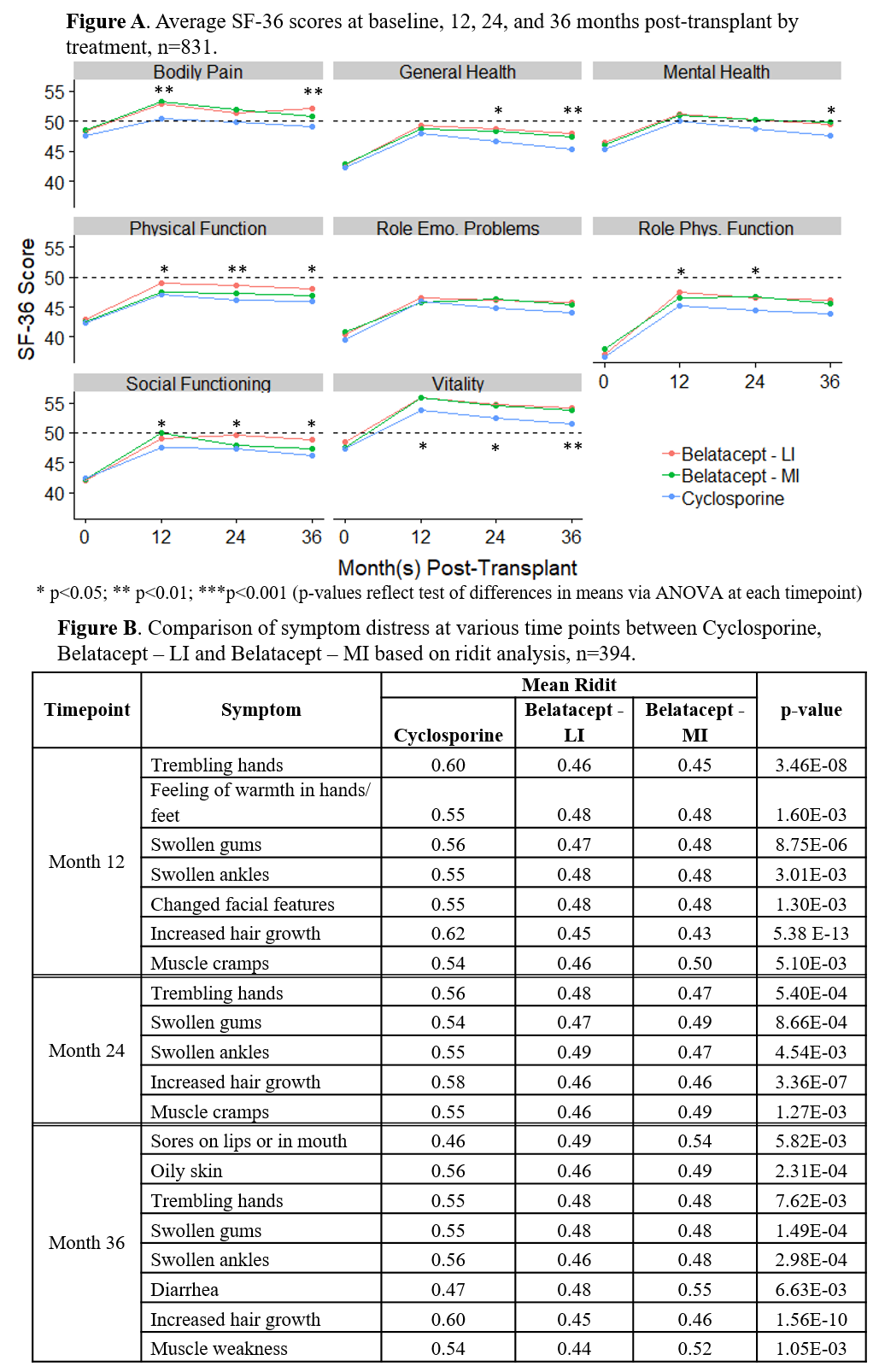Belatacept Treated Patients Experience Improved Health-Related Quality of Life and Lower Symptom Distress Compared to Cyclosporine Treated Patients: An Analysis of the Benefit and Benefit-EXT Cohorts
M. J. Everly1, I. Purnajo1, J. L. Beaumont1, M. Polinsky2, E. Alemao2
1Terasaki Research Institute, Los Angeles, CA, 2Bristol Myers Squibb, Princeton, NJ
Meeting: 2019 American Transplant Congress
Abstract number: 184
Keywords: Immunosuppression, Quality of life
Session Information
Session Name: Concurrent Session: Psychosocial and Treatment Adherence
Session Type: Concurrent Session
Date: Sunday, June 2, 2019
Session Time: 4:30pm-6:00pm
 Presentation Time: 5:18pm-5:30pm
Presentation Time: 5:18pm-5:30pm
Location: Room 208
*Purpose: New immunosuppressive agents in transplant should not only be efficacious but also help patients feel better (i.e. lower patient reported symptoms and improve health related quality of life (HRQoL). Herein, we analyzed patients in the BENEFIT and BENEFIT-EXT trials longitudinally to determine the relative symptom and HRQoL differences between cyclosporine (CsA) and belatacept.
*Methods: Patients were evaluated using the SF-36 (HRQoL) and the MTSOSD-59R (symptom) at baseline, 12, 24, and 36 months post-transplant for SF-36 (n=831) and MTSODS-59R (n=394, inclusive of patients who reported SF-36). We examined change from baseline and differences between treatment groups for all 8 subscales of the SF-36. The most distressing symptoms were identified and compared by treatment over time using ridit analysis.
*Results: Overall, compared to CsA, belatacept treated patient had better HRQoL scores post-transplant across most SF-36 subscales (Figure A). Between treatment groups, there were a higher number of distressing symptoms (p<0.01) in CsA treated patients at 12, 24, and 36 months post-transplant relative to belatacept treated patients. The symptoms that highly differentiated cyclosporine from belatacept were trembling hands, feeling of warmth in hands and feet, swollen ankles, change in facial features, increased hair growth, muscle cramps, and swollen gums (Figure B). No symptoms appeared more distressing in patients treated with the belatacept less intense (LI) regimen.
*Conclusions: Belatacept treatment (compared to CsA) resulted in improved HRQoL and lower symptom distress. Therefore, in addition to some clinical benefit of belatacept (i.e. lower DSA, improved graft survival), belatacept patients also feel better and have a better quality of life.
To cite this abstract in AMA style:
Everly MJ, Purnajo I, Beaumont JL, Polinsky M, Alemao E. Belatacept Treated Patients Experience Improved Health-Related Quality of Life and Lower Symptom Distress Compared to Cyclosporine Treated Patients: An Analysis of the Benefit and Benefit-EXT Cohorts [abstract]. Am J Transplant. 2019; 19 (suppl 3). https://atcmeetingabstracts.com/abstract/belatacept-treated-patients-experience-improved-health-related-quality-of-life-and-lower-symptom-distress-compared-to-cyclosporine-treated-patients-an-analysis-of-the-benefit-and-benefit-ext-cohorts/. Accessed December 29, 2025.« Back to 2019 American Transplant Congress

